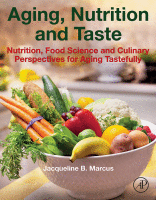Browse content
Table of contents
Actions for selected chapters
- Full text access
- Book chapterAbstract only
Chapter 1 - Global and US Aging
Pages 1-24 - Book chapterAbstract only
Chapter 2 - Nutritional and Physical Concerns in Aging
Pages 25-63 - Book chapterAbstract only
Chapter 3 - The Senses, Chemosensory Changes and Aging
Pages 65-104 - Book chapterAbstract only
Chapter 4 - A Taste Primer
Pages 105-140 - Book chapterAbstract only
Chapter 5 - A Smell Primer
Pages 141-172 - Book chapterAbstract only
Chapter 6 - Flavor Enhancement Ingredients
Pages 173-206 - Book chapterAbstract only
Chapter 7 - Flavor Enhancement Techniques
Pages 207-247 - Book chapterAbstract only
Chapter 8 - Meeting Nutritional and Disease-Specific Needs of Aging
Pages 249-295 - Book chapterAbstract only
Chapter 9 - Culinary Considerations for the Aging
Pages 297-337 - Book chapterAbstract only
Chapter 10 - Recipes and Menus That Appeal to Aging Palates
Pages 339-428 - Book chapterAbstract only
Chapter 11 - Cooking Aids, Tableware Tips and Dining Advice
Pages 429-453 - Book chapterAbstract only
Chapter 12 - Prime Time Resources for Aging, Taste and Health
Pages 455-494 - Book chapterNo access
Index
Pages 495-513
About the book
Description
Approximately 380 million people worldwide are 60 years of age or older. This number is predicted to triple to more than 1 billion by 2025. Aging, Nutrition and Taste: Nutrition, Food Science and Culinary Perspectives for Aging Tastefully provides research, facts, theories, practical advice and recipes with full color photographs to feed the rapidly growing aging population healthfully. This book takes an integrated approach, utilizing nutrition, food science and the culinary arts.
A significant number of aging adults may have taste and smell or chemosensory disorders and many may also be considered to be undernourished. While this can be partially attributed to the behavioral, physical and social changes that come with aging, the loss or decline in taste and smell may be at the root of other disorders. Aging adults may not know that these disorders exist nor what can be done to compensate. This text seeks to fill the knowledge gap.
Aging, Nutrition and Taste: Nutrition, Food Science and Culinary Perspectives for Aging Tastefully examines aging from three perspectives: nutritional changes that affect health and well-being; food science applications that address age-specific chemosensory changes, compromised disease states and health, and culinary arts techniques that help make food more appealing to diminishing senses. Beyond scientific theory, readers will find practical tips and techniques, products, recipes, and menus to increase the desirability, consumption and gratification of healthy foods and beverages as people age.
Approximately 380 million people worldwide are 60 years of age or older. This number is predicted to triple to more than 1 billion by 2025. Aging, Nutrition and Taste: Nutrition, Food Science and Culinary Perspectives for Aging Tastefully provides research, facts, theories, practical advice and recipes with full color photographs to feed the rapidly growing aging population healthfully. This book takes an integrated approach, utilizing nutrition, food science and the culinary arts.
A significant number of aging adults may have taste and smell or chemosensory disorders and many may also be considered to be undernourished. While this can be partially attributed to the behavioral, physical and social changes that come with aging, the loss or decline in taste and smell may be at the root of other disorders. Aging adults may not know that these disorders exist nor what can be done to compensate. This text seeks to fill the knowledge gap.
Aging, Nutrition and Taste: Nutrition, Food Science and Culinary Perspectives for Aging Tastefully examines aging from three perspectives: nutritional changes that affect health and well-being; food science applications that address age-specific chemosensory changes, compromised disease states and health, and culinary arts techniques that help make food more appealing to diminishing senses. Beyond scientific theory, readers will find practical tips and techniques, products, recipes, and menus to increase the desirability, consumption and gratification of healthy foods and beverages as people age.
Key Features
- Presents information on new research and theories including a fresh look at calcium, cholesterol, fibers, omega-3 fatty acids, higher protein requirements, vitamins C, E, D, trace minerals and phytonutrients and others specifically for the aging population
- Includes easy to access and usable definitions in each chapter, guidelines, recommendations, tables and usable bytes of information for health professionals, those who work with aging populations and aging people themselves
- Synthesizes overall insights in overviews, introductions and digest summaries of each chapter, identifying relevant material from other chapters and clarifying their pertinence
- Presents information on new research and theories including a fresh look at calcium, cholesterol, fibers, omega-3 fatty acids, higher protein requirements, vitamins C, E, D, trace minerals and phytonutrients and others specifically for the aging population
- Includes easy to access and usable definitions in each chapter, guidelines, recommendations, tables and usable bytes of information for health professionals, those who work with aging populations and aging people themselves
- Synthesizes overall insights in overviews, introductions and digest summaries of each chapter, identifying relevant material from other chapters and clarifying their pertinence
Details
ISBN
978-0-12-813527-3
Language
English
Published
2019
Copyright
Copyright © 2019 Elsevier Inc. All rights reserved.
Imprint
Academic Press
